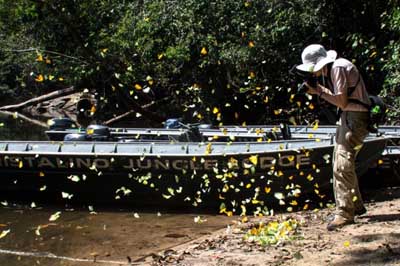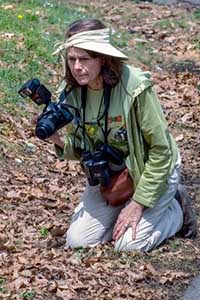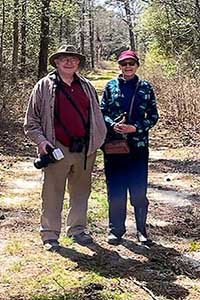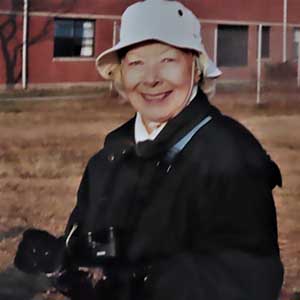December 14, 2022
Setting the Stage: Hammers and a Landing Craft
Spring on GGI began right on schedule, and, thanks to your support, Matthew Male and the carpentry team were able to spend a month getting the island ready for the re-tern of the terns, as well as a re-tern to a full summer of research and monitoring. The carpenters built new raised walkways to move equipment from the dock to the Carpenter’s Shop, built new tent platforms to house students, and installed safety railings on some precarious stairways. We installed nearly ¼ mile of new fencing around the Big Gun and other points on the island where the Army fort presents notable “falling” hazards for the tern chicks. This is always a hurry-up operation as we thread the window between spring’s arrival, and the arrival of the terns – but all the work was completed.
There were two other major tasks to tackle before the birds arrived – battling the invasive weeds that crowd the terns out of their nesting spaces, and gathering marine debris that washed up on the island. With the help of USFWS’ Suzanne Paton, the USFWS landing craft team from McKinney National Wildlife Refuge, and University of Rhode Island students, we were able to get boatloads of marine debris off the island. That work needs to be done each year, but the result is a GGI that is safer for the adult and young birds.
Back Home
The island was Tern-Ready for their arrival on May 2, 2022, when the first birds came home. The trip for the Roseate Terns from the northern coast of Brazil, and the Commons from Brazil and the coast of Argentina, is long and difficult, and their arrival is always inspiring. The terns were not alone in this homecoming. After two years of extremely reduced staffing due to COVID-19 precautions we were able to field a team of seven students and researchers throughout the season. The reduced staffing is necessary because the old dorms are no longer usable, and the physical plant just can’t keep up with more people. This limits the scale of some of the work we can do, but we are learning how to make this work.
Egg, Chick, Band, Feed, Fledge
Nesting proceeded “as expected”, and soon GGI was covered in Common and Roseate nests. New nesting “pup tents” were occupied by the Roseates, and the Commons squeezed into every inch, as usual. Researchers and students from Mass Audubon, University of Connecticut, CEMAM/University of Rio Grande do Norte in Brazil, and University of Rhode Island carried on monitoring the terns. All Roseate Tern nests were marked and counted (about 1,787 Roseate nests), and we continued to use the area “upstairs” (above the Carpenter’s Shop) as our index plot to let us know how the Commons were doing (the number was within 1 nest of the total for the same area in 2021)!
A sample of the Roseate and Common chicks were banded with metal as well as plastic bands with large, easy-to-read codes, and we looked for those chicks every other day until fledging to estimate the survival of chicks. Many of the Roseates were not possible to find regularly, so we spent hundreds of people-hours searching for them at fledging time. This gave us a productivity estimate for both species. We were able to do the “following” by watching with scopes or binoculars from blinds around the island. This reduced our time in the colony, and also lets us gather some other data, like feeding rates, as well as the type of fish delivered to the nests (spoiler alert – it was a BIG mackerel year).
During the fall, URI and UCONN students returned again to help with marine debris cleanup, and helped to close down the island. Invasive plant work continued, and, if all goes well we expect to have even more nesting space on GGI next year.
What’s Next?
In August 2022 the American Museum of Natural History, Mass Audubon, and UCONN hosted seabird and climate change experts from across the US to help build a long-range conservation and climate adaptation plan for GGI. This work is funded by the Long Island Sound Futures Fund, and will set us up with a plan for continuing the important annual monitoring and management work that the terns need to thrive on GGI. At the same time, we need to plan for the future – a future with stronger storms and rising sea levels. The planning will identify strategies for ensuring GGI is able to be a home for the terns for decades to come.
Some of these strategies will be large-scale erosion control. Other strategies will be small scale, and will be designed to provide safe nesting spaces to move terns incrementally above the ever-rising high water mark. Still other strategies will be employed to increase our vigilance for any introduced pathogens or predators, and to be able to respond to the unexpected – this is all part of the plan to ensure the island is resilient in the face of climate change.
Grants, gifts, a healthy dose of “can-do”, chocolate-covered donuts, and a dedicated cadre of supporters has been the engine that transformed GGI from an abandoned Army base, into one of the largest seabird colonies in the United States. That funding engine is as important now as it ever was. The island needs significant improvements to the physical plant (more solar power, replace the defunct dorms with cabins, install a small desalinating unit for drinking water), to the monitoring program (optics, new observation blinds, support for lab work to monitor for disease, support for the fish monitoring program), and also needs support to continue to provide the safest nesting habitat for the terns.
We are thankful for your past contributions and ask that you please consider making a donation to “Great Gull Island Project-AMNH” and sending it to:
Helen Hays, Director
GGI – Department of Ornithology
American Museum of Natural History
200 Central Park West
New York, NY 10024
Thank you very much and we look forward to the Spring of 2023 when we welcome the terns home again!
Sincerely,
Helen Hays, Director
Joe DiCostanzo, GGI Associate
Margaret Rubega, UCONN
Peter Paton, URI
Joan Walsh, Mass Audubon
Joel Cracraft, AMNH














